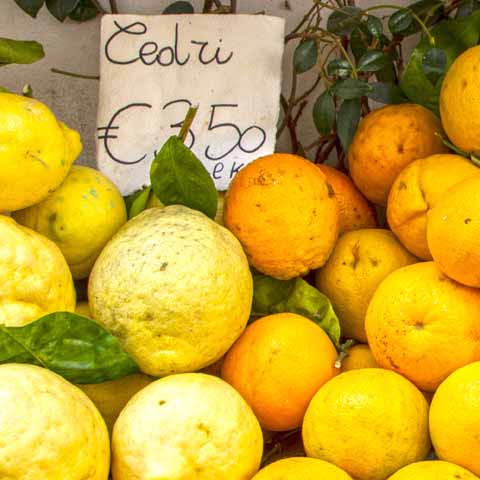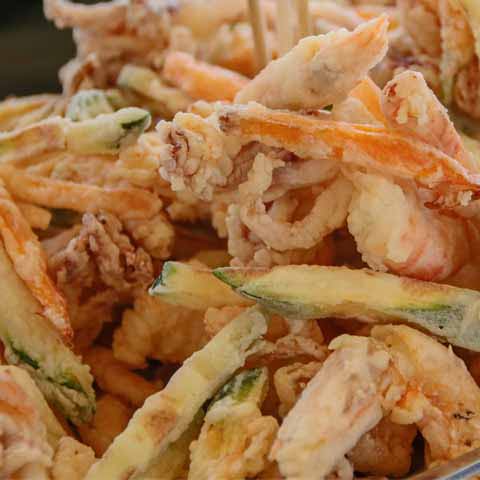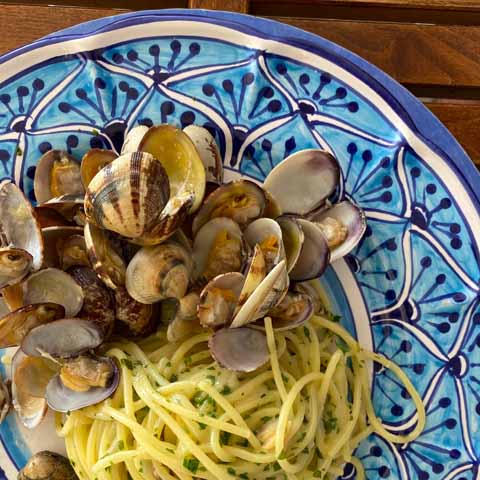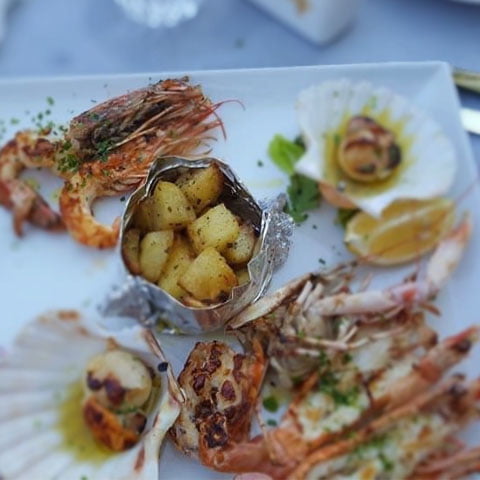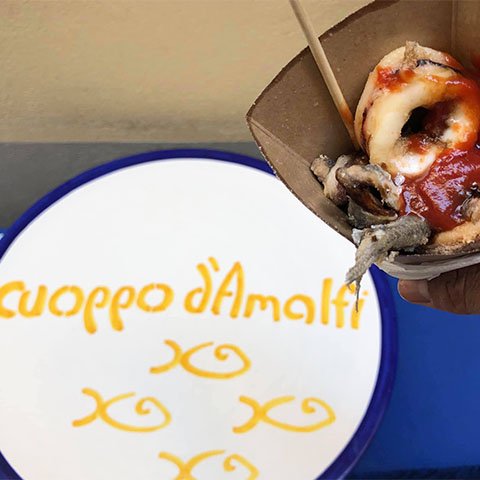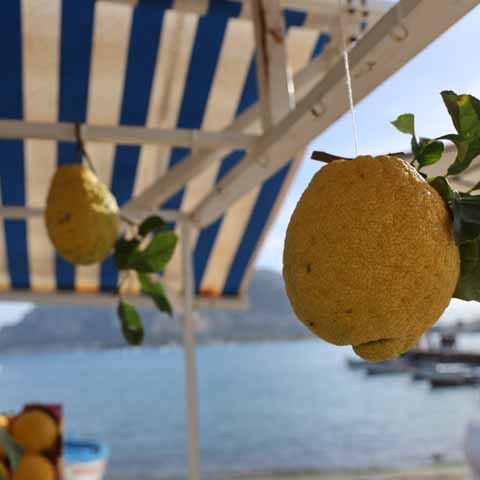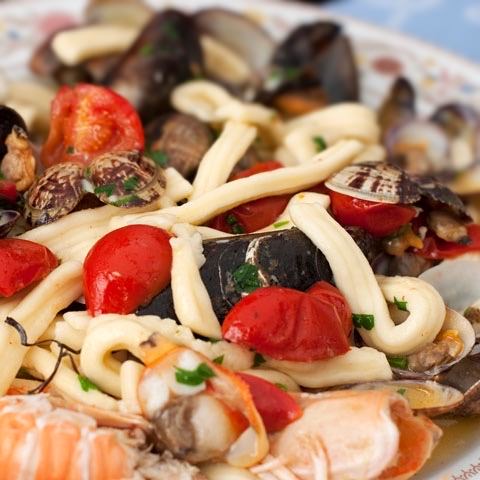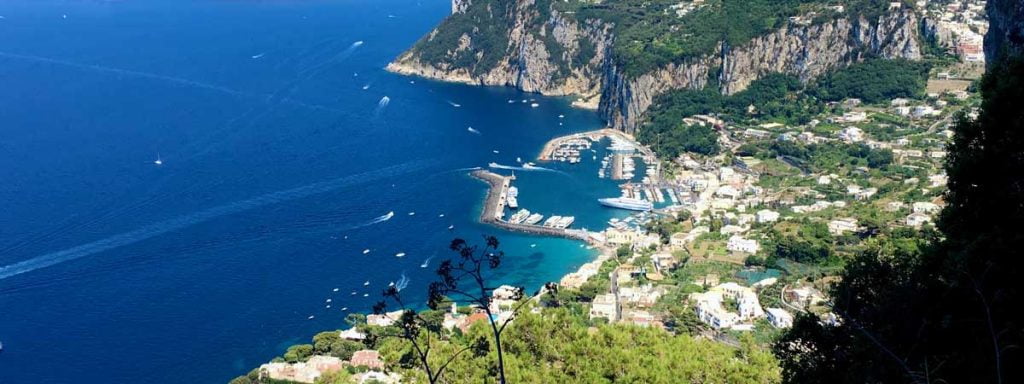The Amalfi Coast is one of the premier vacation destinations in Italy, often selected for its gorgeous sea views, yet the cuisine of this region is equally impressive. Whether you are visiting one of the coast’s characteristic towns such as Positano, Amalfi, Ravello, Minori, or Cetara, spectacular local dishes are designed to nourish and delight travelers from near and far.
Though each town has its own traditions and methods of cooking, generally speaking the cuisine of the Amalfi Coast is a reflection of its surroundings: fresh seafood from the Tyrrhenian Sea and a variety of vegetables and fruits cultivated in the hillside terraces.
Among the typical products of this area, perhaps the most iconic is the Limone Costa d’Amalfi (Amalfi Coast Lemon), which is a product of Protected Geographical Indication (PGI). Produced only in the towns of the Amalfi Coast and their hamlets, the Amalfi Coast Lemon is distinct from all other Italian lemons, even the ones grown in the nearby Sorrento area. The Amalfi Coast Lemon is characterized by a light-yellow color, a peel of medium thickness, and an intense aroma. Rich in essential oils and vitamin C, the pulp of the lemon is juicy with a moderately acidic taste and a scarce number of seeds.
The lemons, grown in local “lemon gardens” can be harvested all year round thanks to the area’s mild climate, however, the best lemons are said to be those picked between March and July. The lemons are known to grow to medium or large size weighing on average between 3.5 oz. and 4 oz. With a fresh flavor emblematic of the Amalfi Coast, the local lemons are typically enjoyed uncooked as an accompaniment to appetizers, seafood, pasta, meat, and even desserts. Of course, the lemon is also used to make the Amalfi Coast’s famous limoncello, a liqueur that perfectly showcases the coast’s local star.
As with other parts of Italy, when dining at locations along the Amalfi Coast, plan to dedicate approximately two hours for a complete Italian dinner experience. Meals are served in several courses consisting of an appetizer, first course, second course, side dishes, and dessert. And, of course, don’t forget the fabulous wine! Let time slip away in the company of new friends as you gather around the dinner table to enjoy and celebrate.
For the ultimate Amalfi Coast dining experience, plan to eat at least one of your meals seaside during sunset for a magical experience that perfectly combines Italian cuisine and breathtaking ambiance.
APPETIZERS
Appetizers in Italy typically include a mouthwatering assortment of locally cured meats and rich, traditionally made cheeses. Along the Amalfi Coast, travelers can expect to find fresh, locally produced mozzarella. This remarkable cheese can be made from either cow milk or buffalo milk. The buffalo milk mozzarella made in the Amalfi Coast towns as well as the rest of the province of Salerno, called mozzarella di bufala campana (buffalo mozzarella from Campania), is a product with a Protected Designation of Origin (DOP) and is highly prized in Italy and internationally. The cow milk mozzarella produced in the area, which can be referred to as fior di latte, is excellent as well. When in the Amalfi Coast, do not miss the chance taste some of the best mozzarella Italy has to offer.
Other common local cheeses include ricotta, provolone, and goat cheese from the Monti Lattari (Lattari Mountains). These cheeses can be paired with local salame and may also be served up with anchovies, sun-dried tomatoes, or freshly made bread.
Naturally, seafood features prominently in the local appetizers, with one example being cuppetiello. Translated as “small cup,” cuppatiello consists of a small paper cone filled with fried local seafood. Common ingredients include calamari, anchovies, and little fish called paranze. Served with small wood skewers to pick up the fish and paired with only a lemon wedge, this dish is a true classic of the coast.
FIRST COURSE
Italy is known worldwide for its pasta, and the Amalfi Coast is no exception to this rule. Pasta of all shapes and sizes, both fresh and dried can be found on the menus here.
A popular first course is the regional favorite of scialatielli ai frutti di mare. Native to the Amalfi Coast, scialatielli are strips of pasta that are shorter and thicker than spaghetti with an irregular, square, and somewhat curved shape. Scialatielli are a bit unusual compared to other homemade paste because grated pecorino and finely chopped basil is added to the dough. Considered to be a light pasta shape, scialatielli pair perfectly with the local seafood.
Visitors will often find scialatielli ai frutti di mare on menus of Amalfi Coast restaurants, which is scialatielli with mixed seafood such as clams, mussels, shrimp, calamari, and more. This dish is usually served with local tomatoes, olive oil, and parsley—simple ingredients that let the flavors of the seafood shine through. Scialatielli may also be served with only one type of seafood (such as shrimp), with a combination of seafood and vegetables (such as zucchini), or with vegetables only.
Additionally, in the Amalfi Coast and in coastal areas throughout the Campania region, mixed seafood may be served with other pasta shapes, such as spaghetti. This pasta with mixed seafood preparation is typically called either ai frutti di mare or allo scoglio. Other common seafood pasta preparations include alla vongole (with clams) and ai gamberi (with shrimp).
In the restaurants of Minori, travelers may have the opportunity to sample another pasta that is out of the ordinary called ‘ndunderi. Considered by UNESCO to be one of the oldest types of pasta in the world, ‘ndunderi originated in the village of Minori. During the time of the Ancient Romans, this pasta was likely made with farro flour and rennet, while today it is made with fresh cow’s milk ricotta, eggs, and flour. The dough is shaped into dumplings and traditionally ‘ndunderi are only served with fresh tomato sauce.
Another pasta shape from Minori is ricci or riccioli, which can also be called fusilli furitani. This is a spiral shaped pasta that is typically three to five inches long. Ricci have been made by hand for more than one hundred years in Minori and the surrounding area. In Minori’s restaurants, ricci are usually served with sausage ragù, but this pasta shape also pairs well with other meat sauces, as well as seafood or a simple tomato sauce.
One typical pasta dish hailing from Positano is called bucatini alla caporalessa. Bucatini, which is a long rounded pasta shape with a hole running down the middle that is thicker than spaghetti, is not native to the Amalfi Coast, but the preparation of this dish is. Dating back to the late nineteenth century, bucatini alla caporalessa was invented at a restaurant in Positano and consists of bucatini with eggplants, provola cheese, peeled tomatoes, olives, capers, basil, and grated parmigiano.
In Cetara, the local pasta dish visitors must try is spaghetti con la colatura di alici. Colatura di alici is a transparent, amber colored oil that is extracted from local anchovies after they have been brined and allowed to ferment. Cetara’s anchovies are renowned throughout Italy and in addition to colatura, the anchovies can be served fried, marinated, or grilled as part of an appetizer or second course. The dish spaghetti con la colatura di alici features unsalted spaghetti, since colatura is very salty, and is served with colatura di alici plus small amounts of garlic, chili pepper, and parsley.
SECOND COURSE
With the Amalfi Coast’s prime location along the Tyrrhenian Sea, locally caught and fresh seafood accounts for most of the region’s second course offerings. Whether it is stand-alone seafood or it is combined with other local ingredients, travelers can expect to see menus featuring the likes of anchovies, various varieties of whitefish, crab, shrimp, octopus, mollusks, and more. These fish dishes are typically grilled, poached, or braised, and all are sprinkled with the juice of the local lemons.
One traditional way to prepare fish in the area is called pesce all’acqua pazza. Usually featuring branzino (bass) or orata (gilt-head bream), this dish consists of poached fish cooked with locally grown tomatoes, olive oil, herbs, and white wine. A unique aspect of the dish is that the fish is served with plenty of cooking liquid. This may be alluded to in the dish’s name, which translates to crazy water. The flavorful broth made during the cooking process is arguably one of the best parts of the dish and is the reason why it is served with plenty of crusty bread—be sure to soak up every last drop!
Another must-try seafood dish is totani e patate, or red squid and potatoes. To prepare this dish, the squid is sliced then sauteed in olive oil with garlic and onions, followed by the potatoes, which are sauteed in the same pan then seasoned with salt and chili pepper. This combination of seafood and vegetables is characteristic of the Amalfi Coast, showcasing the best of its local ingredients from the sea and agricultural terraces. Do not let the short list of ingredients fool you, this dish is simply bursting with flavor.
Tonno alla positanese is an excellent choice for tuna lovers. As you can guess from the name, this tasty tuna dish originates from Positano. After searing the tuna on both sides, a tomato sauce is prepared with onion, white wine, tomato pulp, parsley, and bay leaves. The tuna is braised in the sauce for about an hour to soak up all of the flavors and then it is served.
SIDE DISHES
As mentioned above, colatura di alici from Certara can be featured in pasta dishes, but it can also be used to enhance second courses and side dishes. The oil may accompany fish dishes or vegetables. Just like in the other areas of Italy, sauteed vegetables are a key side dish in the Amalfi Coast, with spinach and chard considered to be two common local offerings. Here the vegetables can be prepared with olive oil, garlic, chili pepper, and colatura di alici. Some locals may even drizzle colatura di alici on olives, tomatoes, or sandwiches.
STREET FOOD
As you stroll up and down the steep roads of the cities of the Amalfi Coast, it is entirely possible to work up an appetite between meals. Common street food fare found on the Amalfi Coast can include seafood offerings, such as fried seafood served in paper cones with a wood skewer and a lemon wedge. No matter what type of street food you indulge in, consider enjoying it seaside for a delicious snack that comes with spectacular scenery.
DESSERT
Be sure to pace yourself when it comes to enjoying your meal, because it would be a travesty not to save room for dessert.
Lemons are grown throughout the Amalfi Coast and are an integral part of the culinary culture appearing in everything from limoncello to desserts to non-edible items such as candles and perfume. So, it is no surprise that the star dessert of the Amalfi Coast is the delizia al limone. This indulgent and citrusy sponge cake is soaked in limoncello then covered with a lemon frosting. Travelers can expect to find delizia al limone at the major pastry shops of the Amalfi Coast—just follow the scent of lemon. This dessert that is emblematic of the Amalfi Coast simply cannot be missed.
Another dessert favorite is torta caprese. Though it was invented in nearby Capri and is considered to be the traditional dessert of the island, today this special cake can be found in many restaurants along the Amalfi Coast as well. It is a flourless cake and decadent treat made from butter, eggs, sugar, chocolate, and almonds. A generous sprinkling of powdered sugar is the proverbial cherry on top for this delicious cake. According to legend, a local chef on the island of Capri was preparing a chocolate cake and forgot to add flour. Nonetheless, the diners enjoyed the cake that was prepared and torta caprese was born.
The unique dessert melanzane al cioccolato, which was invented in the town of Maori, combines two unusual ingredients: eggplant and chocolate. Typically prepared for the Ferragosto holiday on August 15, this layered dessert consists of fried eggplants soaked in chocolate and covered with almonds, amaretti cookies, and grated dark chocolate.
Last but not least, is a dessert native to the Amalfi Coast that has received international acclaim: the sfogliatella. This tasty treat was invented in the town of Conca dei Marini during the seventeenth century by nuns living at the Santa Rosa Monastery. The dessert was made using leftover ingredients and was named sfogliatella Santa Rosa in honor of the saint to whom the monastery is dedicated. Though there have been many variations over the years, today the principal types of sfogliatella in the Amalfi Coast include the sfogliatella riccia, which is made with puff pastry and composed of many thin layers, and the sfoagliatella frolla, which is a smooth version without the layers and made of short crust dough. Both types can be served with a filling of ricotta and candied fruit. They may also be topped with pastry cream and additional fruit plus a generous amount of powdered sugar.
WINE
As delicious as the food is in this stunning region of Italy, no dining experience here is complete without sipping the area’s locally produced wines or liqueurs.
The majority of the wine produced in the Amalfi Coast is Costa d’Amalfi DOC, which can be red, white, or rosé. The local red wines usually feature aglianico, piedirosso, and sciascinoso grapes. The white wines, on the other hand, typically derive from falanghina and biancolella grapes, which locally may be referred to as biancazita and biancatenera.
Of particular note are the wines produced in the towns of Ravello, Tramonti, and Furore. The wines of these areas are highly prized and have been recognized as official variations with a separate name based on the town. The full names of these wines would be Costa d’Amalfi Ravello DOC, Costa d’Amalfi Tramonti DOC, and Costa d’Amalfi Furore DOC, but often they are referred to only by their city names, such as Ravello DOC. These wines come in white, rosé, red, and special reserve red.
Although it is not wine, it would be a disservice not to mention the area’s locally made limoncello. It is a resident and visitor favorite. Neighboring Sorrento and several of the cities of the Amalfi Coast such as Amalfi, Maiori, and Minori, offer it daily. Traditionally served as an after-dinner drink to aid in digestion, visitors to the Amalfi Coast are often encouraged to taste it any time of the day.
Another characteristic liqueur of the Amalfi Coast is called concerto. Originating in Tramonti, this liqueur is made from fifteen different spices that harmoniously come together “in concert,” hence the name. As one of the oldest liqueurs of the Amalfi Coast, it was originally invented as a therapeutic drink. Some of the traditional spices used to make concerto include licorice, cloves, fennel, nutmeg, and edelweiss.
Italy’s Amalfi Coast offers a variety of interesting culinary delights and natural treasures, leaving a lasting memory for all who visit.
The Cities of Campania:
Don't just see Italy, live it.
Your dream trip to Italy has never been closer
No more endlessly scrolling travel sites. Our travel experts will craft the perfect, one-of-a-kind trip just for you.

300+
DESTINATIONS
We offer more Italian destinations than any travel site. Do and see more with Trips 2 Italy.
1 (of a kind)
ITINERARIES
Because your dream trip to Italy should be designed for you, not for the masses.
100%
PEACE OF MIND
From flights and accommodations, to food and activities - we take care of every detail.
